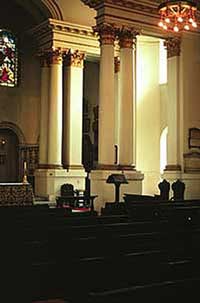
How Do Visual Arts Shape Spiritual Life?
Building Anglican Liturgy

Photo courtesy of the author
St. Mary Woolnoth, London
![]()
Building Anglican Liturgy
Response: Giving
Form to Anglican Liturgy in the City Churches of London
John W. Dixon, Jr.
These elements are fundamental but they are not simple. There is a multitude of interpretations among different Christian churches and it is those interpretations that have to inform the vision of the architect. The Eucharist can range from High Mass to a simple commemorative meal and this determines whether the church has an altar or a table. Having a separate pulpit and lectern has one symbolic meaning, combining them another. Which does a particular church make a part of its worship? The Methodist churches I attended as a boy had a combined pulpit and lectern in the center of an elevated platform. Below the pulpit on a level with the congregation was a massive wooden table and a railing. The buildings had little architectural distinction but the arrangement was reasonably faithful to the life of those churches.
What should be the focal point of the building? My boyhood churches clearly focused on the pulpit. The focus of a medieval church was the high altar, remote from the people and clearly the province of the priests. The pulpit had no architectural relevance but was hung on a pillar in the nave. Many of the great European cathedrals retain the high altar in the traditional place but have made another altar in the crossing. It is still a high altar but now brought closer to the people, thus shifting the liturgical weight, the center of liturgical gravity.
The Dutch Reformed Church of the Resurrection in Amsterdam has the pulpit-lectern on one side of the platform, the baptismal font on the other. At the center of the platform is a plain wooden table with benches at the foot of a large wooden cross. I suspect it makes for a slow service but the emotional and psychological effect must be tremendous, taking communion at the foot of that great cross, bathed in a soft light like Easter morning.
The creativity of the architect is needed to give space and expressive form to the faith and action of a church. But the creativity of the architect must be just that: giving form to the faith and to the devotional action of the particular church.
Historically, the Anglican tradition has not focused on artistic expression. Its great contribution to the larger church is the Prayer Book. While there has been much to-do with church furnishings and ornamentation and some attention to stained glass, there is little else. The city churches of London, however, are not only an important contribution to the arts, they also define the issues of Anglicanism. An awareness of these remarkable churches could enable us to understand more clearly what building an Episcopalian church is all about.
Christopher Wren had a clear sense of what was required of him and a firm grasp of the central problem of building an Anglican church. This we can know, partly by certain statements he made, partly by attending to the buildings he built. I am giving priority to Wren in this regard. Hawksmoor began as Wren's assistant before succeeding him as a master. He used his own architectural vocabulary with startling power and originality but his basic treatment was faithful to his own master.
